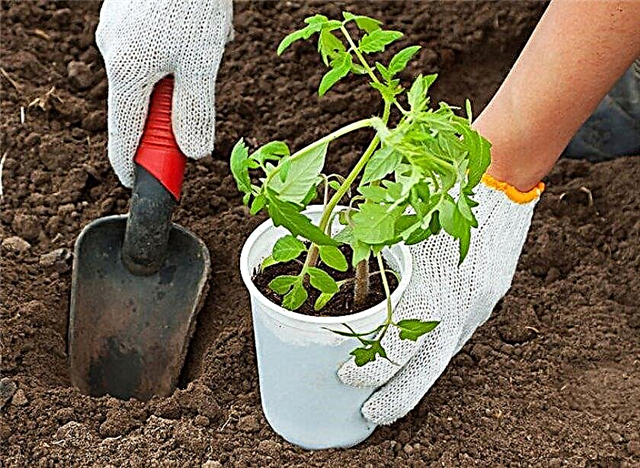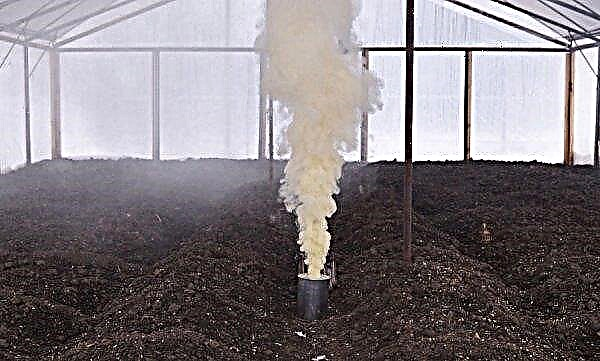Among gardeners, tomato Maryina Grove F1 has earned the fame of one of the most successful species for cultivation in a greenhouse. Bushes of this culture will be able to grow even beginners in vegetable growing. If you have not had experience with this wonderful variety, then its properties and high yield indicators will definitely not leave you indifferent. In addition to the description of the tomato, the article presents detailed agricultural techniques for its cultivation, visual photos, as well as the nuances of care.
Grade description
To begin, consider what this variety is:
- the culture is among the hybrid varieties;
- plants are characterized by unlimited growth (indeterminate type), the standard height is 150-170 cm;
- early ripening, may bear fruit in the offseason;
- gives 7–9 ovaries on each hand;
- plants have good foliage;
- green leaves and a typical form for tomato bushes;
- the shape of the tomatoes is round, there are samples with a small "tail";
- the average weight of one fetus is 145–170 g; with proper care, this parameter can increase to 200–250 g;
- ripe fruits are painted in bright scarlet color;
- the pulp is fleshy, rather dense, the taste of the pulp is ordinary, unremarkable, there is only a slight acidity.

Advantages and disadvantages
Taking into account the main difficulties that have to be encountered in the cultivation of greenhouse tomatoes, specialists managed to create an almost universal hybrid.
- Among the main advantages of Marina Grove F1 can be distinguished:
- good tolerance of deficiencies in care: difference in temperature readings, increased humidity, etc.
- early ripening and the ability to produce crops in a greenhouse all year round;
- the variety is high-yielding - with 1 square. m you can get 16-17 kg of ripe fruit;
- good resistance to the main viral and fungal "tomato" diseases (fusarium wilting, mosaic, brown spotting, late blight);
- excellent presentation (fruits are noteworthy for their large size);
- high preservation of fruits (tomatoes do not deteriorate during storage);
- good transport tolerance.
- The minuses of the variety include:
- the impossibility of growing in open beds in areas with cold winters;
- troublesome plant care;
- the unremarkable taste of the fruit, which is why they are more suitable for the preparation of preservation or boiling of tomato juice.
Self-growing seedlings
To obtain healthy and strong seedlings of Maryina Grove, it is necessary to adhere to the standard rules of agricultural technology for growing tomato crops, and also take into account some features of the indeterminate variety.
Did you know? The world's largest tomato managed to grow American farmers from Wisconsin. Its weight was 2.9 kg.
Sowing dates
If you plan to transplant young bushes into open beds in the future, then you should sow the seeds at the end of winter or at the beginning of March. Plants should have time to grow stronger by the time of transplantation to a permanent place.
In heated rooms with additional lighting, sowing work can be carried out at any time of the year.
The soil
Maryina Grove needs a loose, organic-enriched substrate, therefore, before sowing, the soil must be fertilized with a vitamin mixture. For the purpose of disinfection, the earth should first be poured with the composition of sodium humate. The level of soil acidity in this case does not play a big role.

Below are examples of soil mixtures that are excellent for growing seedlings of Maryina Grove:
- one part of turf land, one part of peat, one part of humus, as well as 1 small spoon of superphosphate, the same amount of potassium sulfate and 1 large spoon of wood ash;
- 1 liter can of river sand, 1 large spoon of superphosphate, a similar amount of wood ash, half a bucket of humus, half a bucket of peat.
Important! For the cultivation of Maryina grove in a greenhouse, sand or peat is absolutely not suitable. In winter, such soil quickly freezes, and in summer it overheats excessively.
Capacity for growing
As containers for seedlings, various paper, clay, plastic or ceramic containers are suitable. Today, many gardeners use peat tablets. "Cassettes" for seedlings and individual plastic cups with a collapsible bottom are also very popular.
Be sure to sanitize all containers, even new ones. Soak containers in a strong potassium permanganate composition for half an hour, then rinse the container thoroughly under running water.
Seed preparation
Before sowing, carefully sort the seeds, discarding substandard samples. Then the raw materials must be disinfected - immerse the seeds in a weak solution of potassium permanganate and leave there for at least 30 minutes. Then, after thoroughly washed and dried planting material, keep it in the refrigerator for about 12 hours.

Seeds of tomatoes under consideration are not necessary to pre-soak. But in order to accelerate their germination, they can be kept in a warm solution of a growth stimulator (Epin-Extra, Kornevin, Silk) for about 10-12 hours. Now you can start sowing seeds in the ground.
Sowing seeds
Sow the seeds of Maryina Grove in the greenhouse according to this scheme:
- Moisten the prepared soil mixture a little and scatter it over the selected containers.
- Level and tamp the earth a little.
- In each container with the ground, make shallow holes (approximately 1–1.5 cm).
- Sow 3-4 copies of seeds in each groove, at a distance of a couple of centimeters from each other.
- Sprinkle planting material with soil mixture.
- Use a spray gun to moisten the surface of the soil.
- It is advisable to cover the containers with a film.
Did you know? About 95% of the tomato mass is water.
Seedling Care
Saplings are rather exacting to external conditions. Before the first shoots appear, the pots should be kept in a lit and heated place where the temperature does not drop below +22 ° C. The first sprouts can be seen after a week.
Add organic fertilizer to the seed container regularly. Keep the soil moist. When the sprouts appear, provide them with good lighting. Water once every 7–8 days. On the 14th day after the emergence of young plants, feed the bushes with a nitrophose. And after 3 weeks, seedlings can be moved to a permanent place.

Seedling hardening
Before planting in the ground, the grown young bushes need to be hardened in the open air, that is, adapted to street conditions. If we talk about specific dates, then it is advisable to start the event 15 days before planting.
Important! When hardening seedlings, the scorching sun can threaten. Strong winds and low temperatures are also dangerous. Take out plants only in the shaded and protected from wind and drafts places.
So, for 10-14 days, take out containers with sprouts to the street for about 30-40 minutes.
Planting seedlings in a permanent place
The most favorable time for transplanting seedlings is the end of April or the beginning of May. By this time, plants should grow stronger.
Transplantation scheme:
- Plant seedlings in rows, calculating the distance between them at 1–1.2 m.
- To make the roots fit freely in the grooves, make them pretty deep. The optimal distance between plants is 75–90 cm.
- Carefully remove the seedlings from the containers, holding the rhizome with the hands with the substrate.
- Dip the bushes into the grooves to the first row of leaves. Fill the holes with earth, crushing it with your hands.
- Form a shallow funnel around each seedling to simplify watering.

Features of outdoor care
Caring for Maryina Grove in open beds has its own nuances and difficulties, which will be discussed later.
Watering
Watering should not be carried out too often and with excessive portions of water: the earth in the garden should always be slightly moist, but not wet and not dry. To achieve this effect, use a superficial type of furrow irrigation.
Water the seedlings on average 1-2 times a week. Water should be settled and warm. To carry out irrigation work, choose the evening time. When watering, it is recommended to use special watering cans.
Fertilizer application
Begin to feed seedlings should be 15 days after transplanting into open garden beds. You can apply nitrofoska (1 tbsp. L. To 10 liters of water). Fertilize greenhouse tomatoes 3-4 times throughout the growing season. Mix liquid nutrient solution with irrigation water.
As liquid top dressing, it is recommended to make:
- superphosphate (1 tablespoon) and ash (2 tablespoons) per 10 liters of water;
- azofosku (1 tbsp. per 10 liters of water).

Shaping and tying a bush
Form the actively growing tomato plants before the end of the growing season (do pinching, removing stepsons and lower leaves). Shrub formation is recommended in 2-3 stems. To pinching the shoots growing from axillary buds, proceed from an early age of the plants. In northern climates, this procedure is mandatory. But in the southern regions, where there is more sun, you can not cut off the stepsons entirely. The best time of day for such work is early morning. The main thing is that the heat does not stand on the street.
As the growth of tomato shoots must be tied to a reliable support in the form of wooden vertical pegs. But do not pull the stem when tying, otherwise you will not wait for fruiting. Later, when the tomatoes begin to ripen, tie up brushes with ripening fruits.
Did you know? The fruits of tomato bushes for a long period of history were considered poisonous and unsuitable for use in food. In Europe, they were cultivated as rare plants with beautiful bright fruits. In France, they decorated arbors, and in England, tomatoes were grown in greenhouses. In the 16th century Dutch literature, there are references to the fact that tomato bushes adorned the gardens of Antwerp.
Soil care
The soil under the bushes must be maintained in a swollen state. To do this, from time to time, loosen the earth in the garden. Loosening not only prevents the hardening of the surface of the beds, but also helps the process of air exchange in the soil and the flow of water deeper. Fluff the soil between rows of beds at least once every two weeks. The permissible depth of cultivation is 5–8 cm. A deeper treatment can damage the roots of plants. If the earth is heavy, you can harrow it deeper - but only those places where there are no roots yet.
Each time after watering or precipitation, cover the soil with a layer of mulch. The site also needs to be regularly and thoroughly cleaned of weeds, that is, weeding.

The tomato variety Maryina Grove F1 surprisingly managed to combine impressive yield indicators and high resistance to tomato ailments. If you are the owner of a greenhouse and want to get large beautiful tomatoes, then you should think about growing this variety.














